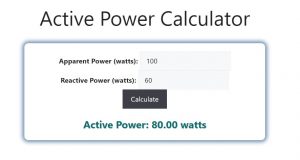About Active Power Calculator (Formula)
The Active Power Calculator is an essential tool for electrical engineers and technicians who work with alternating current (AC) systems. Active power, also known as real power, represents the actual power consumed by electrical devices to perform useful work. It is crucial for understanding energy consumption, efficiency, and load calculations in electrical systems. By using this calculator, users can easily determine the active power based on the apparent power and reactive power, helping them optimize their electrical systems and ensure proper functioning of devices.
Formula
The formula for calculating active power is:
Active Power = Square root of (Apparent Power^2 – Reactive Power^2).
How to Use
- Gather Measurements: Obtain the values for apparent power (in volt-amperes, VA) and reactive power (in volt-amperes reactive, VAR) for the electrical system you are analyzing.
- Input Values: Enter the values of apparent power and reactive power into the Active Power Calculator.
- Calculate: Click the “Calculate” button to determine the active power in watts (W).
Example
Suppose you have an electrical system with an apparent power of 100 VA and a reactive power of 60 VAR. To calculate the active power, follow these steps:
- Input Apparent Power = 100 VA.
- Input Reactive Power = 60 VAR.
- Active Power = Square root of (100^2 – 60^2)
= Square root of (10000 – 3600)
= Square root of 6400
= 80 W.
Therefore, the active power for this system is 80 watts.

FAQs
- What is active power?
Active power is the portion of electrical power that performs useful work in a circuit, measured in watts (W). - What is apparent power?
Apparent power is the product of the current and voltage in an AC circuit, measured in volt-amperes (VA). - What is reactive power?
Reactive power is the power that oscillates between the source and load in an AC circuit, measured in volt-amperes reactive (VAR). - Why is it important to calculate active power?
Calculating active power helps in determining energy consumption, system efficiency, and load management in electrical installations. - How does power factor relate to active power?
The power factor is the ratio of active power to apparent power, indicating the efficiency of power usage in an electrical system. - Can active power be negative?
Yes, active power can be negative in certain situations, such as when energy is fed back into the grid. - What is the relationship between active, reactive, and apparent power?
They are related through the formula: Active Power = Square root of (Apparent Power^2 – Reactive Power^2). - How do I measure apparent and reactive power?
Apparent power can be measured using a power meter, while reactive power can be measured using a wattmeter designed for AC systems. - What happens if reactive power is too high?
High reactive power can lead to inefficiencies in the electrical system, causing increased losses and reduced capacity. - Is it possible to improve the active power of a system?
Yes, optimizing the power factor through capacitors or other means can improve the active power in a system. - What is a power factor correction?
Power factor correction involves adding capacitive or inductive loads to improve the power factor and reduce reactive power. - What tools can I use to calculate active power?
You can use calculators, software, or electrical meters to calculate active power accurately. - Can I calculate active power in a three-phase system?
Yes, the same principles apply, but you need to account for phase angles and use appropriate formulas for three-phase power. - What is the significance of active power in industrial applications?
In industrial applications, active power is crucial for ensuring machines operate efficiently and effectively. - What factors affect active power consumption?
Factors include load type, equipment efficiency, and overall power factor in the electrical system. - Is there a difference between AC and DC active power?
While the concept of active power applies to both AC and DC, the calculations differ due to the sinusoidal nature of AC currents. - How does temperature affect active power?
Temperature can affect the resistance in electrical components, thereby impacting overall active power consumption. - What are the consequences of underestimating active power?
Underestimating active power can lead to insufficient supply, equipment damage, and inefficient operation. - How can I monitor active power in real-time?
Real-time monitoring can be achieved using power meters with monitoring capabilities or smart energy management systems. - What role do transformers play in active power calculation?
Transformers affect the voltage and current levels, which can influence the calculations of active, reactive, and apparent power.
Conclusion
The Active Power Calculator is a valuable resource for anyone working with electrical systems. By understanding and accurately calculating active power, users can optimize energy consumption, enhance system performance, and ensure that electrical devices operate efficiently. With the proper measurements and calculations, managing electrical systems becomes more straightforward, leading to improved safety and effectiveness in energy use.